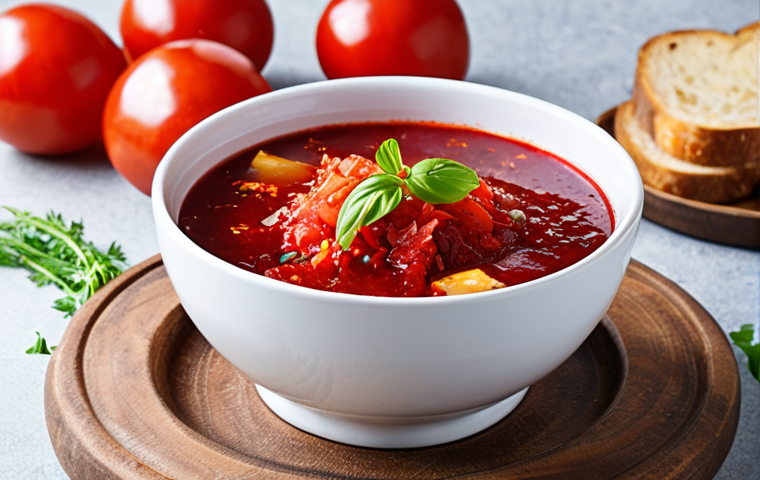Have you ever tasted a soup that just wraps you in a warm hug, comforting you from the inside out? For me, that’s undeniably Borscht. The very first time I spooned this vibrant ruby-red elixir on a crisp autumn evening, I wasn’t just enjoying a meal; I was experiencing centuries of Russian culinary tradition in a single, soulful bowl.
It’s a testament to how simple ingredients—beets, cabbage, and a hearty broth—can coalesce into something so profoundly satisfying. What’s truly fascinating is how Borscht, an age-old staple, remains so incredibly relevant today.
Through conversations I’ve followed online and even quick dives into recent trends, it’s clear this iconic soup is far from a static relic. It’s actively sparking discussions about its evolving identity, inspiring contemporary chefs to reimagine it with innovative twists, and continually proving its adaptability to modern palates.
It makes you wonder how such a timeless dish will continue to shape our culinary landscape.
We’ll get into the specifics now.
Unearthing the Roots: A Culinary Journey Through Time

The Ancient Whispers: Tracing Borscht’s Humble Origins
When I first delved into the history of borscht, I was genuinely surprised by how far back its roots go, stretching much further than just the familiar beet-based soup we know today.
Originally, this wasn’t even about beets! The earliest iterations, primarily found in what is now Ukraine, revolved around fermented hogweed (a plant called *borshch* in Old Slavic, hence the name) or other sour agents like kvass or sour rye bread.
Imagine that – a hearty, tangy broth, likely a staple for farmers and laborers, providing sustenance and warmth through harsh winters. It wasn’t until the 16th century, or even later for widespread adoption, that the humble beet, arriving from the Americas, truly took center stage, transforming borscht into the vibrant, ruby-red masterpiece we cherish.
This evolution fascinates me; it’s a living testament to how food traditions adapt and incorporate new ingredients, constantly reimagining themselves while holding onto a core identity of comfort and hearty sustenance.
This deep dive into its origins made me appreciate every spoonful even more, knowing I was partaking in a dish with such a rich, evolving narrative.
Geographic Kaleidoscopes: Regional Variations That Tell a Story
What truly captivates me about borscht, having explored its culinary landscape, is the sheer diversity it embodies across different regions. It’s far from a monolithic dish.
Just as you’d never find two grandmothers making the exact same apple pie, borscht has countless family secrets and regional quirks. When I traveled through Eastern Europe, I saw firsthand how each country, and even different parts within a country, proudly lays claim to its own unique version.
You have the hearty Ukrainian borscht, often with potatoes and sometimes even a dollop of sour cream and fresh dill, reflecting its agricultural bounty.
Then there’s the Russian variant, which can sometimes be sweeter, featuring ingredients like beef or chicken, and often served with pampushky (garlic bread).
Poland has its *barszcz*, which can be a clear, strained consommé, perfect for sipping, especially around Christmas. And let’s not forget the “green borscht,” popular in spring and summer, which swaps beets for sorrel, giving it a bright, tangy kick.
I even heard tales of fish-based borscht near coastal areas! This incredible variety isn’t just about ingredients; it’s about history, local produce, climate, and the distinct cultural palate of each region.
It really drives home the point that food is a living, breathing part of identity.
Beyond the Beet: Decoding Borscht’s Flavor Symphony
The Core Ensemble: Key Ingredients That Harmonize
When you think of borscht, the first image that probably pops into your mind is that deep, almost jewel-like red of the beet. And while beets are undoubtedly the star, giving borscht its signature color and a subtle earthy sweetness, the true magic lies in the symphony of other humble ingredients that support and elevate them.
From my own kitchen experience, I’ve learned that a good borscht is a careful balance. You’ve got the robust foundation of a good broth – whether it’s beef, chicken, or a rich vegetable stock, it sets the stage.
Then come the essential vegetables: cabbage, carrots, onions, and often potatoes. Each plays a crucial role. The cabbage adds texture and a subtle, comforting earthiness; carrots bring a natural sweetness and vibrant color; onions provide an aromatic base; and potatoes contribute that lovely starchy heartiness.
And let’s not forget the tangy elements like vinegar, lemon juice, or even a splash of beet kvass, which brightens the entire dish and deepens the beet’s hue.
Finally, a touch of garlic and a bay leaf, perhaps a few peppercorns, round out the flavors, creating a complex, layered taste that is much more than the sum of its parts.
It’s truly a masterclass in making simple ingredients sing.
Balancing Acts: Achieving That Perfect Sweet and Sour Zing
The hallmark of a truly memorable borscht, for me, isn’t just its color, but that exquisite balance between sweet and sour. It’s a tightrope walk that, when executed perfectly, makes the soup incredibly moreish and satisfying.
The sweetness primarily comes from the beets and carrots, which caramelize beautifully when sautéed. But relying solely on their natural sugars won’t give you that authentic, vibrant taste.
This is where the sour element comes in, and it’s where different cooks show their individual flair. I’ve experimented with various souring agents: a good splash of apple cider vinegar, a squeeze of fresh lemon juice, or even the traditional beet kvass if I’m feeling particularly ambitious.
Some recipes even call for tomatoes or tomato paste, which add both acidity and umami depth. The trick is to add these sour elements gradually, tasting as you go.
Too much and it’s overwhelmingly tart; too little and it can taste flat or overly sweet. It’s a nuanced process, and one I’ve come to love, as it allows for personal expression within a classic framework.
The slight tartness cuts through the richness, brightens the earthy beets, and leaves your palate refreshed, craving just one more spoonful. It’s this careful dance between contrasting flavors that elevates borscht from a simple soup to a deeply comforting and sophisticated culinary experience.
The Art of the Simmer: Crafting Your Own Bowl of Comfort
Prep Power: The Foundation of Flavorful Borscht
From my own experience in the kitchen, I’ve learned that while borscht might seem like a simple soup, the way you prepare your ingredients is absolutely foundational to its final flavor and texture.
This isn’t just about chopping; it’s about understanding how each vegetable interacts with heat and other ingredients. I always start by meticulously preparing my vegetables: finely shredding the cabbage, julienning the carrots and beets (or grating them if I want a smoother texture), and dicing the onions and potatoes.
The order in which you add them to the pot is also crucial. Typically, onions and carrots go in first, sautéed until softened and slightly caramelized, which builds a fantastic flavor base.
Then, I add the beets, sometimes even roasting them beforehand to deepen their sweetness and color, before incorporating them into the pot. This pre-treatment of ingredients, especially the sautéing, is what unlocks their full potential and ensures that the flavors meld beautifully as the soup simmers.
It’s a small detail, but one that genuinely transforms the final dish from “okay” to “absolutely phenomenal.”
The Simmering Secret: Patience for Perfection
If there’s one secret ingredient to a truly soul-warming borscht, it’s patience. This isn’t a soup you rush. Once all your ingredients are in the pot and simmering gently, that’s when the real magic happens.
I’ve found that allowing the borscht to simmer for a good hour, sometimes even longer, is non-negotiable. This prolonged, gentle heat allows the vegetables to soften perfectly, the flavors to intermingle and deepen, and the beautiful ruby color to fully develop.
As it simmers, the aromas that fill your kitchen are just incredible – a mix of earthy beets, sweet carrots, and the savory richness of the broth. I often find myself stirring occasionally, just inhaling the scent and anticipating the warmth it will bring.
It’s during this simmering phase that you can also fine-tune the seasoning, adding salt, pepper, and that crucial touch of acidity to balance everything out.
Trust me, resist the urge to crank up the heat and speed things along. The difference a slow, loving simmer makes is palpable; it transforms a collection of ingredients into a truly cohesive, deeply comforting, and flavorful masterpiece that tastes like pure love.
Pairing Perfection: What to Serve with Your Borscht
Classic Companions: Traditional Sides to Elevate Your Bowl
When I picture a truly authentic borscht experience, it’s never just the soup alone. The traditional accompaniments are just as vital, adding layers of flavor, texture, and cultural significance.
The absolute must-have, in my opinion, is a generous dollop of *smetana* or sour cream. Its cool, tangy creaminess cuts through the richness of the soup beautifully, creating a delightful contrast.
I remember the first time I had it served this way, the simple act of swirling the cream into the vibrant red broth felt like an art form, instantly elevating the dish.
Another classic is a sprinkle of fresh dill, which provides a bright, herbaceous note that simply sings with the earthy beets. And, of course, a good hearty bread is essential for soaking up every last drop of that delicious broth.
Often, this means a slice of dense rye bread, or if you’re lucky, *pampushky* – soft, garlicky Ukrainian rolls that are absolutely divine. These aren’t just sides; they’re an integral part of the borscht ritual, enhancing every spoonful and making the meal feel complete.
Beyond Tradition: Modern Twists and Creative Pairings
While I adore the traditional pairings, I’ve also had a lot of fun experimenting with modern twists and creative accompaniments that complement borscht surprisingly well.
For instance, sometimes I’ll serve a side of crispy roasted potatoes, or even a small, vibrant green salad with a light vinaigrette to offer a fresh counterpoint to the soup’s richness.
I’ve also seen borscht paired with savory pastries, like small cheese turnovers, which add another dimension of texture and flavor. And if you’re feeling adventurous, a drizzle of high-quality olive oil or even a sprinkle of toasted sunflower seeds can add an unexpected richness and crunch.
For a truly unique experience, I once had a chef serve a deconstructed borscht with a small portion of slow-cooked short ribs on the side, allowing you to combine them as you wished – it was a revelation!
These modern approaches show how a classic dish can evolve, inviting new flavors and textures to the party without losing its essential charm. It’s all about playing with contrasts and adding elements that surprise and delight the palate.
Borscht in the Modern Kitchen: Reinvention and Revelation
Adapting for Dietary Needs: Borscht for Every Palate
One of the most remarkable aspects of borscht, and something I truly appreciate as a home cook, is its incredible adaptability. In today’s diverse culinary landscape, with so many different dietary preferences and restrictions, borscht shines as a dish that can easily be modified without losing its essence.
I’ve personally experimented with making it vegan by simply swapping out meat broths for a rich vegetable stock and ensuring all other ingredients are plant-based.
It’s amazing how deeply flavorful a vegetarian borscht can be, especially when you focus on caramelizing the vegetables and using umami-rich ingredients like mushrooms or nutritional yeast.
For those avoiding gluten, it’s naturally gluten-free, provided you’re mindful of any cross-contamination. I’ve also seen lighter versions made with less oil or leaner broths for those watching their calories.
This versatility means that almost anyone, regardless of their dietary needs, can enjoy a warm, comforting bowl of borscht. It’s a testament to the dish’s fundamental goodness that it can be so many things to so many people, yet always remain unmistakably borscht.
Global Stage: How Borscht is Captivating Chefs Worldwide
It’s fascinating to observe how borscht, a dish steeped in Eastern European tradition, is increasingly making waves on the global culinary stage. I’ve been following food trends for years, and what I’m seeing now is a true appreciation for its depth and versatility among chefs from all corners of the world.
No longer confined to traditional Eastern European restaurants, you’ll find modern bistros and high-end dining establishments reinterpreting borscht with innovative twists.
I recently read about a Michelin-starred chef who created a borscht consommé, clarifying it to an almost ethereal transparency, and serving it with delicate beet ravioli.
Others are infusing it with unexpected spices or serving it chilled as a refreshing summer soup. Even fusion restaurants are taking inspiration, perhaps adding a touch of Asian aromatics or serving it alongside Latin American inspired proteins.
This global embrace isn’t just about novelty; it’s about chefs recognizing the inherent comfort, vibrant color, and complex flavor profile of borscht and giving it the sophisticated platform it deserves.
It’s truly thrilling to witness a beloved, ancient dish being celebrated and reimagined for a new generation of food lovers worldwide.
More Than a Soup: The Cultural Heartbeat of Borscht
Family Tables and Festivities: Borscht as a Symbol of Togetherness
When I think of borscht, my mind instantly drifts to images of warmth, family, and celebration. It’s so much more than just a dish; it’s a cultural touchstone, a symbol of togetherness, especially in many Eastern European households.
I’ve heard countless stories, and experienced some myself through friends, of borscht being the centerpiece of family gatherings, holiday meals, and special occasions.
It’s often the first thing offered to a guest as a sign of welcome and hospitality. I’ve learned that the act of making borscht, often a multi-generational effort, becomes a ritual in itself, with recipes passed down from grandmother to mother to daughter, each adding their own personal touch.
The aromas that fill the kitchen as it simmers are often tied to cherished memories – of laughter, shared stories, and the comfort of loved ones. It’s a dish that evokes a powerful sense of nostalgia and belonging.
This deep emotional connection is what truly elevates borscht beyond mere sustenance; it becomes a warm, edible embrace that embodies the very essence of home and heritage.
A Taste of History: Borscht in Literature and Art
It’s not just in kitchens and family gatherings where borscht makes its presence felt; its cultural footprint extends deeply into literature, art, and even popular culture, underscoring its profound significance.
I’ve stumbled upon references to borscht in classic Russian novels, where it often symbolizes hearth, home, and the simple, enduring pleasures of life, providing warmth and comfort amidst turmoil.
Imagine characters huddled around a table, finding solace in a steaming bowl during harsh winters or times of hardship. Beyond literature, I’ve seen vibrant paintings depicting scenes of domestic life, with a pot of borscht often subtly in the background, anchoring the scene in everyday reality.
Even in modern films and TV shows, a character enjoying borscht can instantly evoke a sense of authenticity, tradition, or a connection to their roots.
This pervasive presence in various forms of artistic expression highlights how deeply ingrained borscht is in the collective consciousness of many cultures.
It shows that food, especially a dish as iconic as borscht, isn’t just fuel for the body; it’s a powerful narrative tool, a symbol that speaks volumes about identity, history, and the human condition.
Troubleshooting Your Borscht: Common Pitfalls and Pro Tips
Avoiding the Pitfalls: Common Borscht Blunders to Sidestep
Even with a seemingly straightforward recipe, making borscht can present a few challenges, and trust me, I’ve made my fair share of mistakes along the way.
One common pitfall I’ve encountered is the dreaded “muddy” color. This usually happens if you don’t sauté the beets and other root vegetables properly, or if you add your acidic component (like vinegar or lemon juice) too early.
The acid helps lock in that vibrant red color, so adding it towards the end is key. Another issue can be an imbalanced flavor profile – too sweet, too sour, or just plain bland.
This often comes from not tasting and adjusting as you go. Borscht is a living dish; it evolves as it cooks, and regular tasting and tweaking are essential.
Overcooking the vegetables can also lead to a mushy, unappetizing texture, so keep an eye on them, especially the cabbage and potatoes. My advice? Don’t be afraid to experiment, but also learn from these common errors.
Each batch is a learning experience, bringing you closer to your perfect bowl.
My Top Tips for a Stellar Borscht Every Time
After countless bowls of borscht – some sublime, some… well, learning experiences – I’ve gathered a few invaluable tips that consistently help me achieve a truly stellar result.
Firstly, always start with a high-quality broth, whether homemade or store-bought. It’s the backbone of your soup. Secondly, don’t rush the sautéing of your initial aromatics (onions, carrots, perhaps beets).
This caramelization builds a deep flavor foundation that you can’t replicate later. Thirdly, remember the acid! A splash of vinegar or lemon juice near the end not only brightens the flavor but also intensifies the beet’s magnificent color.
Fourth, consider adding a bay leaf and a few black peppercorns during the simmer for an extra layer of subtle spice. Finally, and this is crucial for maximum flavor, let it rest.
Borscht, like many stews and soups, often tastes even better the next day as the flavors continue to meld and deepen. Reheating it gently allows those flavors to truly sing.
Trust me, these small steps make a world of difference, turning a good borscht into an unforgettable one.
| Borscht Variation | Key Characteristics | Common Ingredients | Typical Serving |
|---|---|---|---|
| Ukrainian Borscht | Hearty, often includes potatoes and meat (beef/pork), rich flavor. | Beets, cabbage, potatoes, carrots, onions, beef/pork, dill, sour cream. | Hot, with pampushky (garlic rolls) and sour cream. |
| Russian Borscht | Can be slightly sweeter, often with specific meat cuts or chicken, sometimes includes beans. | Beets, cabbage, carrots, onions, often chicken or beef, sometimes kidney beans, sour cream. | Hot, with a dollop of sour cream or mayonnaise, dark bread. |
| Polish Barszcz (Czysty Czerwony) | Clear, strained, often very tart, no solid vegetables in the broth itself. | Beet kvass (fermented beet juice), mushrooms, sometimes dried plums. | Hot, as a sipping broth, often with mushroom uszka (small dumplings) especially for Christmas Eve. |
| Green Borscht (Shchav) | Light, refreshing, seasonal, uses sorrel for its sourness instead of beets. | Sorrel, potatoes, carrots, onions, hard-boiled eggs, dill, sour cream. | Hot or chilled, often with a hard-boiled egg cut in half. |
| Cold Borscht (Lithuanian/Belarusian) | Chilled, vibrant pink, creamy, perfect for summer. | Cooked beets, kefir or buttermilk, cucumber, dill, hard-boiled eggs. | Chilled, often with hot boiled potatoes on the side. |
Concluding Thoughts
As we’ve journeyed through the vibrant world of borscht, it’s clear this is far more than just a soup; it’s a living tapestry woven from history, culture, and pure comfort. From its ancient, humble beginnings rooted in fermented greens to the diverse, beet-red masterpiece we cherish today, borscht truly embodies the spirit of culinary evolution. It’s a dish that transcends borders, bringing warmth and connection to countless tables. I hope this deep dive inspires you to embrace the art of making your own bowl, experiencing firsthand the magic of its balanced flavors and the stories it tells.
Useful Information
1. Borscht often tastes even better the next day, as the flavors have more time to meld and deepen, so consider making a larger batch to enjoy leftovers.
2. It freezes beautifully! Once cooled, portion your borscht into airtight containers and freeze for up to 3 months for a quick, comforting meal anytime.
3. Don’t skimp on the garnishes – a dollop of sour cream (or a dairy-free alternative) and a generous sprinkle of fresh dill are essential for the authentic experience.
4. Experiment with different souring agents like apple cider vinegar, lemon juice, or even a touch of beet kvass to find your preferred sweet and sour balance.
5. While traditional recipes often call for specific meats, borscht is incredibly versatile; a rich vegetable broth makes for an equally delicious and satisfying vegetarian or vegan version.
Key Takeaways
Borscht is a culinary marvel with deep historical roots, evolving from simple fermented greens to the iconic beet soup. Its incredible regional diversity highlights its adaptability, while the perfect balance of sweet and sour flavors makes it uniquely satisfying.
More than just a dish, borscht is a powerful cultural symbol, representing togetherness and home across Eastern European traditions, and it continues to captivate chefs globally with its comforting essence and versatility for modern dietary needs.
Frequently Asked Questions (FAQ) 📖
Q: What makes Borscht such a nutrient powerhouse, beyond just its comforting warmth?
A: Oh, where do I even begin? When I first started digging into what actually goes into that gorgeous red bowl, I was genuinely impressed. It’s not just a comforting meal; it’s practically a liquid multivitamin!
The beets, of course, are the stars – packed with antioxidants, nitrates for heart health, and fiber. Then you’ve got the cabbage, which is a fantastic source of Vitamin C and K.
Add in carrots, potatoes, maybe some beans, and you’re looking at a symphony of essential vitamins, minerals, and dietary fiber that’s incredibly good for your gut.
Honestly, after a hearty bowl, I don’t just feel full and satisfied; I feel genuinely energized, like I’ve given my body a real boost. It’s my go-to when I feel a cold coming on or just need a gentle reset.
Q: You mentioned Borscht is evolving; what are some common variations or new ways people are enjoying it today?
A: That’s the beauty of a dish that’s stood the test of time, isn’t it? It adapts! While the classic beef or pork-based Borscht with a dollop of sour cream is undeniably soul-satisfying, I’ve seen and tried so many fantastic twists.
For a lighter touch, especially in warmer months, a chilled, almost gazpacho-like version is surprisingly refreshing – often made with a lighter broth and lots of fresh dill.
Then there are the purely vegetarian or even vegan iterations, replacing meat with hearty mushrooms, kidney beans, or even lentils, making it accessible to pretty much everyone.
I even had a chef friend, just last year, serve a deconstructed Borscht, almost like an art piece, where the vegetables were individually roasted and then brought together with a clear, intense beet consommé.
It was wild, but it still had that unmistakable “Borscht soul.” It just goes to show, this soup isn’t afraid to get a little modern.
Q: For someone new to cooking or wanting to try it at home, how approachable is making Borscht, and are there any common misconceptions?
A: Believe me, if I can make it, anyone can! I think the biggest misconception about Borscht is that it’s incredibly complicated, perhaps because of its rich history or that deep, vibrant color.
People see that intense ruby hue and think it must require some sort of culinary magic. But honestly, it’s remarkably forgiving. It’s essentially a humble stew – lots of chopping, a bit of sautéing, and then simmering until all those wonderful flavors meld together.
The ingredients are simple, readily available at any major grocery store like Kroger or Whole Foods, and relatively inexpensive. My best advice for a beginner?
Don’t stress too much about “the perfect recipe.” Start with a basic one, trust your instincts with seasoning, and remember that the longer it simmers, the richer the flavors become.
It really does feel like a kitchen hug, and there’s immense satisfaction in creating something so nourishing from scratch.
📚 References
Wikipedia Encyclopedia
구글 검색 결과
구글 검색 결과
구글 검색 결과
구글 검색 결과
구글 검색 결과


